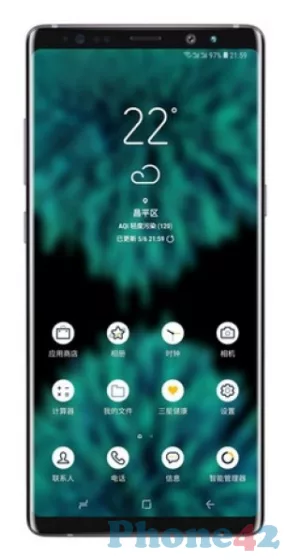
Samsung Galaxy Note9 Exynos (2018)
This phone comes equipped with a 6.4 inch Super AMOLED display, a Exynos 9 Octa 9810 chipset, and 6 GB of RAM.
Is this phone worth its price? Hopefully, it will become clear by the end of my review.
Table of Contents
- Samsung Galaxy Note9 Exynos specifications
- Weight, dimensions, colors
- System, chipset, performance
- Display type, size, resolution
- Memory, storage
- Cameras, flash
- Connectivity, network, wireless
- Battery type, capacity, charger
- Features, sensors, specials
- Verdict, pros and cons
This article shares our personal experiences and thoughts about using the Samsung Galaxy Note9 Exynos smartphone. We hope to offer helpful insights to others interested in this device.

Samsung Galaxy Note9 Exynos specifications
| Brand | Samsung |
|---|---|
| Name | Galaxy Note9 Exynos |
| Model | NOTE9SE |
| Release date | 2018 |
Weight, dimensions, colors
| Colors | black, blue, brown, lilac, purple, silver |
|---|---|
| SIM type | Nano SIM |
Smartphones use a Nano SIM as a small chipcard for a subscriber identity module (SIM).
System, chipset, performance
| OS version | Android OS v8.1 (Oreo) |
|---|---|
| SoC | Exynos 9 Octa 9810 |
| CPU | Octa-core, Quad-core 2.7 GHz Exynos M3 Mongoose, Quad-core 1.95 GHz Cortex-A55 |
| GPU | Mali-G72 MP18 |
The Samsung Galaxy Note9 Exynos comes with Android OS v8.1 (Oreo) out of the box. Android is a mobile operating system. Google built it using a modified version of the Linux kernel. They also used other open-source software. An advanced scheduler manages this octa-core CPU. It assigns tasks to the CPU for real-time speed and power efficiency. Many mobile devices use ARM Mali GPUs. They are well known for their good performance and power efficiency.
Display type, size, resolution
| Display type | Super AMOLED |
|---|---|
| Screen size | 6.4 inch |
| Resolution | 1440 x 2960 px |
| Multitouch support | yes |
AMOLED displays enable an Always-On Display feature. A part of the screen remains active to display the time, date, and notifications. The 6.4 inch display should be big enough for our needs. It will make viewing comfortable. This is true whether we're reading, browsing, or watching. The size of the screen is measured diagonally, from corner to corner.
Memory, storage
| RAM | 6 GB |
|---|---|
| Internal storage | 64 GB |
| Memory card slot | microSD |
The Samsung Galaxy Note9 Exynos comes with 6 GB of RAM, which is considered to be sufficient for most users' needs. More RAM lets us keep more apps and processes open in the background. This keeps the device from slowing down. 64 GB of storage is usually seen as good for a smartphone. It should be enough for most users. We can expand the internal storage (64 GB) with a compatible microSD card.
Cameras, flash
| Main camera | 12 + 12 MP, 4032 x 3024 px, autofocus, optical image stabilization |
|---|---|
| Flash | Dual LED |
| Selfie camera | 8 MP |
Using multiple cameras has advantages. They provide more versatility and creative possibilities. They let us capture a wider range of subjects. The main camera of Galaxy Note9 Exynos has optical image stabilization (OIS). It counters camera shake.
Connectivity, network, wireless
| GSM 2G bands | 850 / 900 / 1800 / 1900 |
|---|---|
| Network coverage | 2G / 3G / 4G |
| Wi-Fi | Wi-Fi 802.11 a/b/g/n/ac |
| Bluetooth | v5.0, A2DP |
| GPS | A-GPS, GLONASS |
| NFC | yes |
| FM radio | yes |
| USB | USB Type-C |
| Headphone | 3.5 mm jack |
The 4G provides faster data transfer speeds compared to previous generations. The phone is capable of connecting to Wi-Fi networks. The Galaxy Note9 Exynos smartphone is capable of connecting to Bluetooth devices. The GPS allows this smartphone to find their exact location. It provides accurate navigation and mapping. The Galaxy Note9 Exynos comes with NFC (Near Field Communication) functionality. The 3.5 mm headphone jack allows us to connect wired headphones or earphones to the device.
Battery type, capacity, charger
| Type | Li-Po 3850 mAh, non-removable |
|---|
The Li-Po 3850 mAh, non-removable battery gives the smartphone a good battery backup. The lithium polymer (Li-Po) battery is a light-weight, rechargeable battery. The battery of Galaxy Note9 Exynos isn't removable without voiding the warranty.
Features, sensors, specials
| Sensors | accelerometer, barometer, compass, fingerprint, gyroscope, hall, heart rate, iris sensor, light, proximity |
|---|---|
| Specials | Corning Gorilla Glass 5, Dual SIM, Fast charging, Wireless charging |
Today, smartphones come with many sensors. They help make the user experience better. The accelerometer is a sensor. It measures the tilting motion and orientation of the phone. The Galaxy Note9 Exynos phone has a fingerprint scanner. The light sensor detects the level of light in the environment. Dual SIM is great for businesses. They want to give staff a device with separate numbers and bills for personal and business use.
The fast charging technology comes in handy when we need quick juice on our device. Wireless charging uses an electromagnetic field. It transfers energy between two objects through electromagnetic induction. Corning Gorilla Glass is tougher. It resists scratches, impacts, and drops.
Verdict, pros and cons
Every phone has its strengths and weaknesses, and this Samsung phone is no exception. As with any device, there are aspects that shine and others that fall short. By examining both sides, we can paint a complete picture of what this phone has to offer. Let's explore its standout features and areas for improvement. Remember, this is just my opinion, and yours might be different.
Pros
- Super AMOLED display
- appropriate screen size
- adequate memory
- microSD slot
- multicamera setup
- optical image stabilization (OIS)
- Dual SIM support
- wireless charging
- Corning Gorilla Glass shield
Cons
- no 5G support
- low-capacity battery
Please let us know if you find incorrect information or something isn't working. Also, tell us if you have a suggestion for improvement.
 I'm Lucas Bradley, the founder of the Phone42.com site. I love technology, especially smartphones, and I've been working with tech stuff for more than 20 years. This means I've seen a lot of changes and have learned a bunch about what makes a good phone. On Phone42.com, I look at all kinds of phones. They can be from big, well-known companies or new ones trying to make their mark. I want to help people understand what's new and cool in the world of smartphones, in a way that's easy to get.
I'm Lucas Bradley, the founder of the Phone42.com site. I love technology, especially smartphones, and I've been working with tech stuff for more than 20 years. This means I've seen a lot of changes and have learned a bunch about what makes a good phone. On Phone42.com, I look at all kinds of phones. They can be from big, well-known companies or new ones trying to make their mark. I want to help people understand what's new and cool in the world of smartphones, in a way that's easy to get.